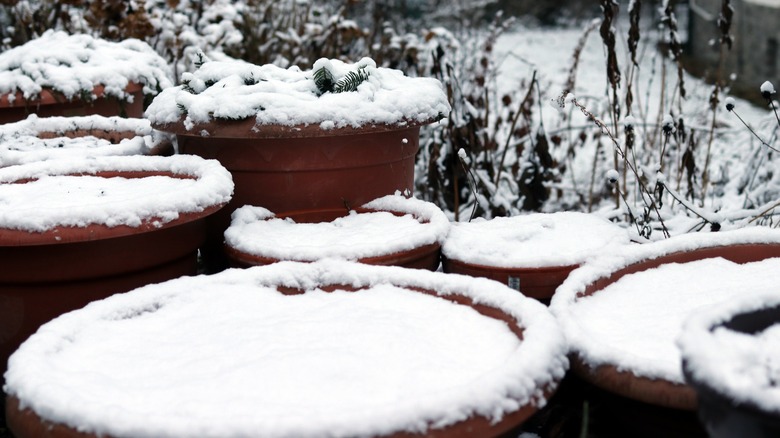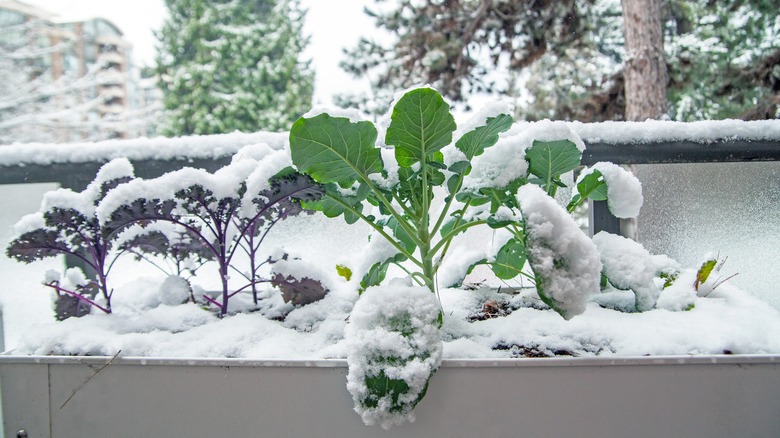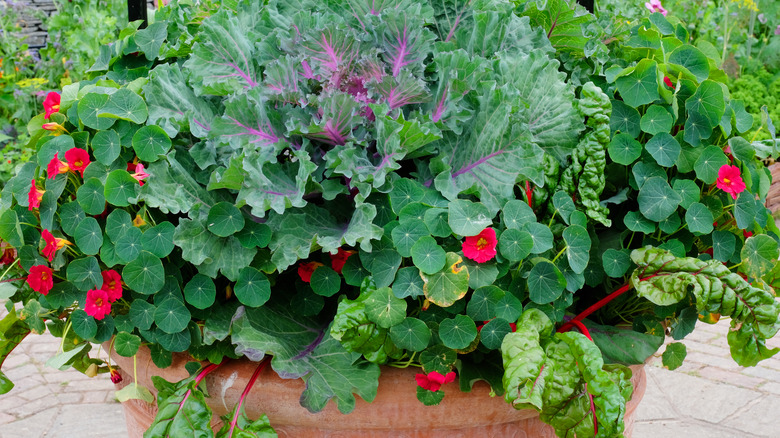The Winter-Hardy Vegetable That Is Perfect For Container Gardening
While it isn't difficult to put together stunning and colorful container gardens in spring, summer, and fall, winter containers can be far more challenging in many regions. But you don't have to pack away your garden pots just because there's snow on the ground. Luckily, some plants can provide you with both a beautiful container garden and delicious leafy greens, even in the depths of winter. One of the best options for adding to a winter container garden is the colorful and delicious Swiss chard.
Despite technically being a type of beet, the root of Swiss chard (Beta vulgaris L. var. cicla) is not edible, and it's instead grown for its stalk and leaves. While chard can generally handle the heat, winter is its time to truly shine. The rugged plants can keep growing until temperatures drop into the mid-20s. This means that in many USDA zones, Swiss chard can grow all winter. If you live in a region where temperatures occasionally dip below the mid-20s, consider bringing your Swiss chard container into a garage or other protected area during cold snaps.
Growing Swiss chard in winter
Swiss chard generally grows to about 2 feet in height, and while it grows best with full sun, it can also handle part shade. Chard thrives in neutral soil with a pH between 6 and 8 but is tolerant of many soil types. Unlike many similar leafy greens, swiss chard isn't sensitive to day length, providing one more reason to grow it year-round. It's also relatively drought tolerant, though chard needs regular water to produce new leaves. If you're growing your Swiss chard in containers, be sure to use well-draining potting soil with a high percentage of organic matter. Don't be afraid to harvest Swiss chard from your containers- as long as you leave some of the plant, it will continue to grow.
One thing to consider when growing Swiss chard and other plants in winter containers is the type of pot or planter. Many popular materials for planters don't handle repeated freezes and thaws well, and terracotta can even crack as a result. Fiberglass, stone, and heavy plastic are all good options for winter container gardens. Larger containers are best as the additional soil will provide your plants' roots some protection from sudden temperature swings, as will a layer of mulch.
Companion planting with Swiss chard
The simple formula for designing a container garden is pairing tall and colorful plants, referred to as "thrillers", with smaller bushier plants, described as "fillers". Sprawling plants that droop out of the container are called "spillers". Many varieties of Swiss chard make perfect thrillers with their height and unusually colored stalks which can come in shades of pink, purple, and even yellow. Depending on the look you are going for, you can either plant a specific color or opt for a rainbow chard mix.
Excellent filler companions for Swiss chard include kale, which is also quite cold-hardy and shade-tolerant. There are many varieties of kale, but ornamental kale grows in an unusual rosette shape and makes an elegant addition to winter planters. The University of Wisconsin-Madison Horticulture Extension notes that many shorter varieties of dianthus can also make perfect companions for Swiss chard. For a cold-hardy spiller element in containers, Michigan State University suggests heucheras, also known as coral bells. If you'd prefer that all elements of your container be edible, then a shorter variety of snow peas could also be an interesting option.


